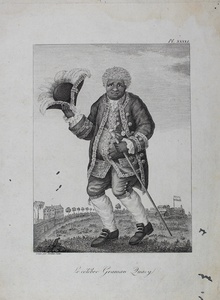| Method | Copper engraving |
| Artist | Pierre Alexandre Tardieu after William Blake |
| Published | c.1796 |
| Dimensions | Image 182 x 132 mm, Plate >260 x 202 mm |
| Notes |
A full length portrait of the healer, botanist, slave and later freedman Graman Quassi. He is pictured in a fine gold lace brocade coat, waistcoat, cane and hat, the outfit being a gift from the Prince of Orange during Quassi's visit to the Hague. The backdrop is a coastal landscape perhaps of Suriname's capital Paramaribo where Quassi lived and died. From J.G.Stedman's 'Narrative of a Five Years' Expedition against the Revolted Slaves of Surinam' published in 1796. Graman Quassi (also spelled Quacy, Kwasi and Quasi) (1692 – 12 March 1787) was a Ghanaian born, Surinamese healer, botanist, slave and later freedman, who is also known for having given his name to the plant species Quassia. As a child Quassi was enslaved and taken to the New World, Suriname in South America, which was a previously British, Dutch Colony. Under the West India Company it was developed as a plantation slave society and became a primary destination for the Dutch slave trade. During his time as a slave, Quassi participated in the wars against the Saramaka maroons as a scout and negotiator for the Dutch, and even lost his right ear during the skirmishes. Quassi developed a reputation as a healer of some renown, one of his remedies being a bitter tea that he used to treat intestinal problems, brewed from the root of the Quassia amara plant which botanist Carl Linnaeus named after him. Quassi used his skills as a witch doctor to accumulate enough money to buy his freedom and travelled to the Netherlands. At an audience with Prince Orange at The Hague he was rewarded for services to the Suriname community with a gold-laced coat, a feathered hat, a gold medal and a gold-headed cane, which he would wear on all possible occasions when in Suriname, exploiting his Royal connection. He is said to have worked on securing the freedom for slaves brought to Holland and through his work was described in contemporary accounts as one of the most extraordinary black men in Suriname. Pierre Alexandre Tardieu (1756-1844) was a French artist and engraver. He was a member of the Institut de France, the Saint Petersburg Academy and the Academy of Milan. His students included Auguste Gaspard Louis Desnoyers and his nephew Ambroise Tardieu (1788 – 1841) who was an eminent French cartographer and engraver, and is celebrated for his version of John Arrowsmith's 1806 map of the United States. William Blake (1757 - 1827) was an English poet, painter, and printmaker. Blake trained and worked as a commercial engraver under the initial tutelage of James Basire. After his apprenticeship, Blake went on to become a student at the Royal Academy. In 1784, Blake set up in business as a print seller in partnership with James Parker. Later in 1788, at the age of 31, Blake began to experiment with relief etching, a method he would use to produce most of his books, paintings, pamphlets and poems. William Blake is regarded as one of the great geniuses in the history of art. He was largely ignored in his own lifetime, yet today is revered as a major reference point for British culture, appealing to a more universal audience than perhaps any other artist. Condition: Trimmed within plate, well outside image. Water stain to top margin. Wormholes to right margin and sky area to the left of the figure, time toning to sheet. |
| Framing | unmounted |
| Price | £150.00 |
| Stock ID | 46157 |

